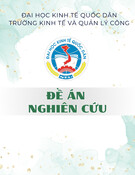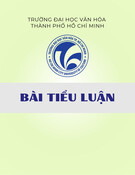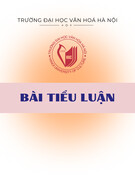
Authors
Correspondence
Keywords
autism,
adaptive behaviour,
intellectual disability
kwells@yorku.ca
Kerry Wells,1
Rosemary Condillac,2
Adrienne Perry,1
David C. Factor3
1 Treatment, Research &
Education for Autism and
Developmental Disorders
(TRE-ADD), Thistletown
Regional Centre
& York University
2 TRE-ADD, Thistletown
Regional Centre
& Brock University
3 TRE-ADD), Thistletown
Regional Centre,
Toronto ON
A Comparison of Three
Adaptive Behaviour Measures
in Relation to Cognitive Level
and Severity of Autism
Abstract
Adaptive behaviour (everyday skills in social and practical
domains; AAMR, 2002) is vital to the understanding of indi-
viduals with developmental disorders, including autism. Several
measures of adaptive functioning are available and deciding
among them can be difficult for clinicians. Conceptually, there
is overlap between adaptive behaviour and other constructs
included in assessments of individuals with autism. Previous
research has found moderate correlations among adaptive func-
tioning, cognitive level, and severity of autism. These are over-
lapping concepts, and the degree to which they overlap relates to
the understanding and usefulness of the measures. This study
examined the utility and construct validity of three widely used
measures of adaptive behaviour, as rated by staff: the Vineland
Adaptive Behavior Scales-Classroom Edition (VABS-Classroom;
Sparrow, Balla, & Cicchetti, 1985), the Scales of Independent
Behavior-Revised (SIB-R; Bruininks, Woodcock, Weatherman,
& Hill, 1996), and the Adaptive Behavior Scale-School-Second
Edition (ABS-S: 2; Lambert, Nihira, & Leland, 1993).
Adaptive behaviour refers to skills in conceptual, social and
practical domains that an individual is able to demonstrate
on a daily basis (AAMR, 2002). Knowledge about adaptive
skills is critical to research, treatment and vocational plan-
ning and is required for the diagnosis of an intellectual dis-
ability, together with cognitive testing (AAMR, 2002; Fenton
et al., 2003; Su, Lin, Wu, & Chen, 2008). However, there is no
universally accepted measure of adaptive behaviour suitable
for all age groups and diagnostic groups.
Cognitive skills are generally measured by directly testing
an individual. The examinee is provided with a series of
tasks and questions that are thought to tap into specific cog-
nitive functions. Adaptive functioning, on the other hand, is
typically measured via interviews or questionnaires that are
given to respondents who are very familiar with the exam-
inee. Skills within the domain of adaptive functioning are
those that an individual demonstrates throughout the course
of his or her typical routine. Therefore, these skills would
not be directly observable to an outside examiner without
significant and lengthy intrusion into the person’s life. As
a result, individuals who are thought to have close know-
ledge of these skills, such as family members, caregivers, and
educators, are asked about the examinee’s adaptive skills via
interviews or questionnaires.

JoDD
56
Wells e t a l .
The present study is concerned with three
widely used measures of adaptive behaviour
that are suitable for school-aged individuals
with autism: the Vineland Adaptive Behavior
Scales-Classroom Edition (VABS-Classroom;
Sparrow, Balla, & Cicchetti, 1985), the Scales
of Independent Behavior-Revised (SIB-R;
Bruininks, Woodcock, Weatherman, & Hill,
1996), and the Adaptive Behavior Scale-School-
Second Edition (ABS-S: 2; Lambert, Nihira, &
Leland, 1993). Table 1 provides a brief summary
of the characteristics of each measure.
Vineland Adaptive Behavior Scales-
Classroom Edition (VABS-Classroom)
The VABS-Classroom edition is a question-
naire designed to assess adaptive behaviours
in school, therefore, it is typically completed
by teachers or other school-based support staff
(Sparrow et al., 1985). The VABS-Classroom is
designed for use with children between the
ages of 3 years and 12 years, 11 months, 30 days.
The VABS-Classroom is composed of 244 items,
each of which falls into one of four domains,
which are further separated into 11 subdomains
(Sparrow et al., 1985). Table 2 shows the cat-
egories found on all three measures of adaptive
behaviour examined in this study.
The VABS-Classroom is reported to have high
internal consistency, ranging from .80 to .95
for the four domains. Test-retest and inter-
rater reliability are not reported for the VABS-
Classroom. Satisfactory construct, content, and
criterion-related validity are reported in the
manual for the VABS-Classroom (Sattler, 2002).
Comparisons between the VABS-Classroom and
the Kaufman Assessment Battery for Children
(K-ABC) revealed correlations typically in the
range of .30s to .40s. The authors examined
the correlation between the VABS-Classroom
(teacher ratings) and the VABS-Survey form
(parent interview) and found correlations ran-
ging from .31 to .54 across domains (Sparrow
et al., 1985). Cicchetti and Sparrow indicate
that the agreement between the VABS-Survey
Edition and the VABS-Classroom are at a level
of acceptable clinical significance, noting that,
“…both the Survey and Classroom editions of
the Vineland can be used to compare either
normal or handicapped children with the stan-
dardization samples…” (1989, p. 621).
Scales of Independent Behavior-
Revised (SIB-R)
The SIB-R is “…designed to measure func-
tional independence and adaptive functioning
in school, home, employment and community
settings” (Bruininks et al., 1996, p. 1) as well as
problem behaviour (not considered in the present
study). This measure can be administered either
as a questionnaire or structured interview. The
SIB-R has been normed for use with individ-
uals from the age of 3 months to over 80 years.
Table 1. Characteristics of VABS-Classroom, SIB-R, and ABS-S: 2
VABS-Classroom SIB-R ABS-S:2
Administration Questionnaire Questionnaire or
structured interview
Questionnaire or
structured interview
Number of items:
adaptive behaviour
244 259 67
Number of items:
maladaptive behaviour
0 8 38
Reported completion time 20 minutes 45-60 minutes 15-30 minutes
Minimum age 3 years 3 months 3 years
Maximum age 12 years 80+ years 21 years
Available domain
scores
Standard score,
percentile, age
equivalent
Standard score,
percentile, age
equivalent
Standard score,
percentile, age
equivalent

v.15 n.3
Measures of Adaptive Behaviour 57
The 259 items of the SIB-R are separated into
14 subscales that are grouped into four adapt-
ive behaviour clusters: Social Interaction and
Communication, Personal Living, Community
Living, and Motor Skills (Bruininks et al., 1996).
The SIB-R is reported to have high split-half and
test-retest reliabilities (Sattler, 2002). The split-
half reliabilities range from .70 to .88 for the
subscales and .88 to .94 for the cluster scores.
Test-retest reliability coefficients range from .83
to .96 across the various scales. Construct valid-
ity of the SIB-R has been established by com-
paring scores on the measure to chronological
age (correlations range from .54 to .73) and to
the Woodcock-Johnson Broad Cognitive Ability
Scale, which produced a correlation of .82.
Adaptive Behavior Scale-School-
Second Edition (ABS-S: 2)
According to the manual, the ABS-S: 2 is
intended to assess the personal and commun-
ity independence, and personal and social per-
formance of school-aged children (Lambert
et al., 1993). The norms for the ABS-S: 2 range
from 3 years to 21 years of age. This measure
has separate norms for individuals with and
without intellectual disabilities. The ABS-S: 2
is separated into two parts: Part One consists
of 67 items (plus one supplemental item for
females) and is focused on personal independ-
ence (Lambert et al., 1993). Part One has been
divided into three factors, nine domains and
18 subdomains. Part Two was not considered
in the present study, but is concerned with the
individual’s maladaptive behaviours.
The ABS-S: 2 is reported to have high internal
consistency reliabilities, ranging from .82 to .99,
and test-retest reliabilities ranging from .42 to
.79. Content validity, as indicated by correla-
tions with the Weschler Intelligence Scale for
Children-Revised (WISC-R), range from .28 to
.59 for the domain scores, and .41 to .61 for the
factors (Sattler, 2002).
The definitions of adaptive behaviour used by
the creators of these measures are similar, but
each is slightly different. As a result, the precise
construct being assessed, despite the fact that all
have been labelled as adaptive behaviour, may
be subtly different. This, in turn, could impact
the degree of correlation between the adaptive
Table 2. Categories of items found on the VABS-Classroom, SIB-R, and ABS-S: 2
VABS-Classroom Domains and
Subdomains
SIB-R Clusters
and Subscales
ABS-S: 2 Factors and Domains1
(Part One)
Communication:
Receptive, Expressive,
Written
Social Interaction and
Communication Skills:
Social Interaction, Language
Comprehension, Language
Expression
Personal Self-Sufficiency:
Independent Functioning,
Physical Development
Daily Living Skills:
Personal, Domestic,
Community
Personal Living Skills:
Eating and Meal Preparation,
Toileting, Dressing, Personal
Self-Care, Domestic Skills
Personal-Social Responsibility:
Prevocational/Vocational
Activity, Self-Direction,
Responsibility, Socialization
Socialization:
Interpersonal Relationships,
Play and Leisure Time,
Coping Skills
Community Living Skills:
Time and Punctuality, Money
and Value, Work Skills, Home/
Community Orientation
Community Self-Sufficiency:
Independent Functioning,
Economic Activity, Language
Development, Numbers and
Time, Prevocational/Vocational
Activity
Motor Skills:2
Gross, Fine
Motor Skills:2
Gross, Fine
1
Domains that are listed under two different factors (Independent Functioning and Prevocational/Vocational Activity) have
individual items that belong to each of those factors
2
Motor Skills are not represented in ABS-S: 2

JoDD
58
Wells e t a l .
behaviour measure and other constructs such
as cognitive functioning, as suggested by the
discrepant correlations with IQ reported above
for each adaptive measure and these relation-
ships may differ in autism as compared with
general intellectual disabilities.
Adaptive Behaviour in Autism
Knowledge of adaptive behaviour is vital to a
comprehensive assessment of individuals who
have autism, many of whom also have develop-
mental disabilities. Tomanik et al. (2007) reported
that, when a measure of adaptive behaviour was
included in the assessment battery along with
the ADI-R (Lord, Rutter, & Le Couteur, 1994) and
ADOS (Lord, Rutter, DiLavore, & Risi, 1999), diag-
nostic accuracy improved by 9%. Consequently,
Tomanik and colleagues recommend including
measures of adaptive behaviour in the assess-
ment of individuals who potentially have autism
in order to improve the accuracy of diagnosis,
which is relevant to treatment planning.
It has often been reported that, for individuals
with autism, adaptive behaviour tends to be
more impaired than their cognitive skills would
predict (Fenton et al., 2003; Gabriels, Ivers, Hill,
Agnew, & McNeill, 2007; Tomanik, Pearson,
Loveland, Lane, & Shaw, 2007) but this may
not be the case at lower cognitive levels (Perry,
Flanagan, Dunn Geier, & Freeman, 2009). It has
also been reported that individuals with aut-
ism tend to have lower overall adaptive skills
than age and IQ matched peers without autism
(Gabriels et al., 2007; Perry et al., 2009). Nuovo
and Buono (2007) found that the adaptive skills
for their sample of individuals with autism co-
occurring with mental retardation, were lower
than for groups of individuals with mental
retardation plus schizophrenia, personality dis-
orders, mood disorders, ADHD, or epilepsy.
Due to some of the traits seen in individuals with
autism, such as, difficulties with communication,
social interactions, transitions, and motivation,
this population is often difficult to assess using
traditional cognitive tests. Because adaptive
measures are based on informant reports, meas-
ures of adaptive behaviour are advantageous
in that they do not require the individual to
respond to an examiner, or to perform any tasks.
Additionally, adaptive behaviour tests measure
the skills an individual demonstrates in their
natural environment, on a daily basis. However,
scales that measure adaptive behaviour also
have their disadvantages. Informant informa-
tion is vulnerable to the biases and point of view
of the respondent. As well, reliability between
informants (e.g., parents and teachers) is often
lower than what one would expect (Cicchetti
& Sparrow, 1989), although this is common in
other areas of assessment as well because differ-
ent respondents make ratings based on differ-
ent samples of behaviour, in different environ-
ments, and with different reference groups in
mind. Tests of cognitive abilities assess skills in
a limited time frame under specific conditions,
and may not accurately illustrate the abilities of
the individual when in a more natural setting.
Because of the flexibility and utility of tests of
adaptive behaviour, they are frequently used to
inform the course of education and treatment,
as well as to document the progress of individ-
uals with autism (Carpentieri & Morgan, 1996;
Gabriels et al., 2007).
There is more research on the use of the
Vineland with individuals who have autism,
than for either the SIB-R or the ABS-S: 2. Some
literature has suggested a profile of responses
for individuals with autism, the age equivalent
scores on the social domain tend to be the low-
est, scores on the communication domain tend
to be in the middle, and the scores in the daily
living domain tend to be the highest (Carter et
al., 1998). However, other researchers have found
that these patterns were not always consistent,
and were dependent upon the level of cognitive
ability and severity of autism (Fenton et al., 2003;
Perry et al., 2009). Although an updated second
edition of the Vineland measure is now avail-
able, the first version was used for this study due
to the retrospective nature of the project, since
the data were collected prior to the release of the
second version of the Vineland measures.
The present study involves participants with
autism and intellectual disabilities. It is import-
ant to know the degree of correlation of differ-
ent measures of adaptive behaviour with both
measures of severity of autism and with cogni-
tive functioning because treatment and educa-
tional programming decisions are often made
based on the needs of the client, as determined
by his or her strengths and weaknesses in
adaptive functioning. The use of different meas-
ures has the potential to impact the scope and

v.15 n.3
Measures of Adaptive Behaviour 59
focus of intervention. If a measure of adaptive
behaviour correlates too highly with measures
of cognitive functioning, the measure may sim-
ply be a proxy for IQ and be omitting import-
ant features of adaptive behaviour that distin-
guish it from cognition. Conversely, we know
from previous research that adaptive behaviour
is, at least, moderately correlated with cognitive
functioning (Freeman et al., 1999; Perry et al.,
2009; Sparrow et al., 1985). As such, if a measure
of this construct is not correlated with cognitive
functioning, likely important features of adapt-
ive behaviour are not being tested (Carpentieri
& Morgan, 1996). Similarly, some research has
shown that a test of adaptive behaviour is likely
to have a moderate negative correlation with
severity of autism (Perry, Condillac, Freeman,
Dunn-Geier & Belair, 2005; Perry et al., 2009),
which is not surprising since socialization and
communication comprise major domains of the
measure and deficits in these areas are charac-
teristic of autism.
This study focused on the extent to which the
VABS-Classroom, SIB-R, and the ABS-S: 2, com-
pleted by staff, correlate with measures of cog-
nitive functioning and severity of autism. There
has been very little research to date looking at
different measures of adaptive behaviour and
examining their relationships to these con-
structs in a comparative way.
Method
This was a file review study that utilized data
collected over a period of 13 years, between
1993 and 2005 at the Treatment, Research and
Education for Autism and Developmental
Disorders (TRE-ADD) program at Thistletown
Regional Centre. A client’s file was included
in the study if it contained one or more of the
VABS-Classroom, SIB-R, or the ABS-S: 2, which-
ever was current best practice at the time of the
assessment. All measures were completed as
questionnaires by TRE-ADD staff, concurrently
(within four months) with the completion of a
test of cognitive functioning and a measure of
severity of autism. Based on these criteria, 82
assessments were located from 50 client files.
In some cases, an individual had more than one
assessment (at different times) using different
measures. All participants had a diagnosis of
autism according to the criteria of the DSM ver-
sion applicable at the time of assessment.
All groups had similar gender ratios and levels
of autism severity. The participants in each of
the groups had a wide age range, although the
mean age was highest for the SIB-R group. The
cognitive levels within each group were compa-
rable, although they were somewhat higher in
the SIB-R group. A summary of the participant
characteristics can be found in Table 3.
The measure of severity of autism used in this
study was the Childhood Autism Rating Scale
(CARS; Schopler, Reichler, & Renner, 1988). The
CARS is an observational measure consisting
of 15 items, each of which is rated on a 7-point
scale by a trained observer. The scores pro-
duced by the CARS range from 15 to 60, with
higher scores signifying increasingly severe
autism symptomology. The CARS is reported to
have high inter-rater reliability, internal consis-
tency, and discriminant validity in this popula-
tion (Perry et al., 2005).
A variety of tests were used to evaluate cogni-
tive functioning, including: the Mullen Scales
of Early Learning (Mullen, 1995), the Bayley
Scales of Infant Development (Bayley, 1993),
the Weschler Intelligence Scale for Children:
Third Edition (WISC-3; Weschler, 1991) and the
Stanford-Binet Intelligence Scale: Fourth Edition
(SB: IV; Thorndike, Hagan, & Sattler, 1986). The
scores that were used from these measures
were the overall cognitive level scores, typi-
cally Mental Age (MA). IQs, if even available,
are often at the floor of the test in this sample.
Therefore, if the test reported an IQ rather than
an MA, MA was then calculated based on the
participant’s chronological age (CA) at the time
of the test and the overall IQ score (MA= IQ
x CA / 100). For participants 12 and older, 12
years was used as their CA. It has been noted
that the growth curve of cognitive development
tends to flatten between the ages of 10 and 12
years for individuals with severe and profound
cognitive impairment (Grossman, 1983). Using
a maximum CA of 12 years when calculating
participants’ Ratio IQ prevents older individu-
als from receiving significantly lower IQ scores
simply because they are older, when in fact,
their MA has remained relatively stable.


























